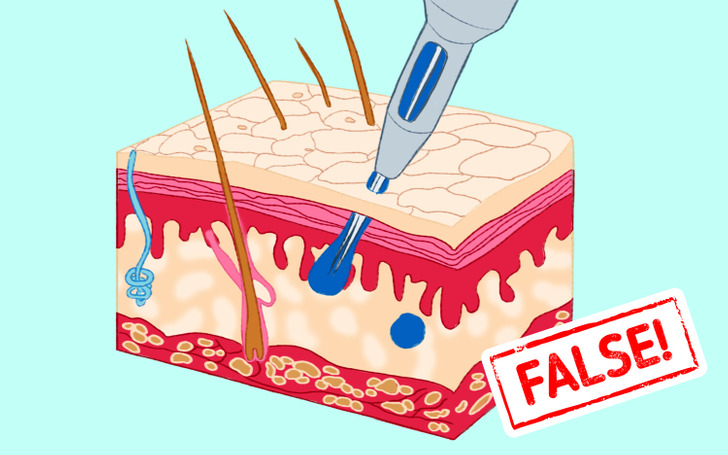14 Strong Hollywood Couples Preserving Tender Feelings for Many Decades

We all know that tattoos are trendy, and more and more folks are choosing to decorate their skin with them. But the tattoo world is still surrounded by a bunch of questions, most of which are just myths. People often wonder if anyone can get a tattoo, if tattoos fade over time, or if certain colors hurt more during the inking process. So, we did some online research to dig into these common tattoo myths. Turns out, most of them are just that — myths. We debunked a few and also figured out the reasoning behind the ones that turned out to be true!
Yes, palm tattoos are prone to fading due to the nature of the skin on the palm of your hand. The skin on your palm has faster re-growth than the rest of your body, which means that the ink in your palm tattoo is likely to fade rather quickly, and will most definitely fade quicker than other tattoos. Touch-ups thereafter will be the only way to keep your palm tattoo looking fresh.
You’ve likely heard the myth that people with tattoos are barred from donating blood. Well, it’s not entirely true. Those with tattoos can indeed donate blood, but there are some conditions they need to meet.
Tattoos involve needles reaching deep into the dermis layer of the skin. If not done properly, this can potentially lead to blood infections. However, after a specific period (which varies by country and medical institution, usually at least 6 months after getting the tattoo), once the risk of blood infection has been ruled out, individuals with tattoos are eligible to donate blood.

As of now, there’s limited evidence suggesting that getting a tattoo poses any specific risks to the health of pregnant women or their babies. Essentially, there doesn’t seem to be an additional risk associated with getting a tattoo during pregnancy. Similar to non-pregnant women, the primary concern revolves around the potential for blood infections resulting from poor hygiene practices at certain tattoo shops or inadequate skills of the tattoo artist.
If you’re considering getting a tattoo while pregnant, it’s worth noting that some doctors advise against getting tattoos on the back. This caution is based on concerns that it might interfere with the administration of an epidural shot during labor. Typically, the needle is inserted outside of the tattooed area to avoid any potential complications with the pigment.
Let’s clear up a common misunderstanding: having diabetes doesn’t mean you can’t get a tattoo. Doctors only suggest avoiding tattooing areas where there’s less blood circulation or where you typically inject insulin. The concern here is mainly about the potential for skin damage in those specific areas.
It’s crucial to note that these recommendations are aimed at individuals who manage their diabetes effectively. For those who neglect their doctor’s advice or have poorly controlled diabetes, there may be risks. Their skin might have compromised healing ability, or their immune response to infections could be weakened, putting them at a higher risk. So, for folks with well-managed diabetes, getting a tattoo is generally safe.
The level of pain you experience during a tattoo isn’t just about your pain tolerance; it also depends on the location of the tattoo. Typically, tattoos hurt more in areas with less fat, like near bones or where there are more nerve endings.
If you’re looking to minimize the pain, you might want to steer clear of getting tattoos on sensitive spots like armpits, ribs, ankles, breasts, elbows, hips, neck, or face, among others. These areas tend to be more sensitive and could make the tattooing experience more uncomfortable.
Getting a tattoo can be a bit painful, but how much it hurts depends on the person. Stories saying tattoos are as painful as giving birth are usually not true. For most people, getting a tattoo feels like scratching a sunburn.
The idea that folks with tattoos might face issues during an MRI due to metallic elements in tattoo ink has circulated, but it’s pretty much a myth. A study by the Max Planck Institute in Germany found that the chances of any significant side effects are incredibly slim, close to negligible. The study highlights only a handful of isolated cases, rather than making it a general rule for people with tattoos.
This idea is completely false. Normally, when you get a tattoo, the tattoo artist saves white for the end, just to make everything a bit brighter and adjust some minor details. But by this time, your skin is most likely already pretty sore from getting ink injected into your dermis for several hours. It’s hardly surprising that you’d feel more pain at that point. But this has nothing to do with the color of the ink — it just happens because your skin is already very sensitive.
This notion is totally off. Typically, when you’re getting a tattoo, the tattoo artist leaves the white ink for the final touches to add some brightness and fix minor details. However, by that stage, your skin has likely been through several hours of getting ink injected into the dermis, so it’s no wonder it’s a bit tender. The increased pain at this point has nothing to do with the color of the ink — it’s just because your skin is already quite sensitive.
Surprisingly, this one checks out, especially for tattoos that are several years old. The ink itself doesn’t turn blue or green; instead, it gets absorbed over time and gradually fades, leaving a bluish tint. This fading can occur either due to the natural aging of the tattoo or if it’s in an area that’s seen a good deal of sunlight.

A tattoo machine has different needles depending on what kind of design you want. A magnum needle can have five to 17 needles. A small round shader can have one to five, and a large one can have seven to 21. For detailed lines, tights have seven to nine needles, while flats have seven to eleven.
It’s not entirely untrue. Hemophilia, a condition that hinders proper blood clotting, comes in varying degrees of severity, from mild to severe. If someone has mild hemophilia, the risk of bleeding issues is lower, and they could consider getting a tattoo with guidance from their doctor. However, for individuals with more serious cases, it’s likely safer to steer clear of tattoos altogether.
Interestingly, there have been instances where individuals with moderate or severe hemophilia got tattoos without major complications. It really depends on the specifics of each case, but it’s always wise to consult with a doctor before making any decisions to avoid any potentially risky surprises.
Attitudes toward tattoos have evolved significantly over the years. These days, it’s pretty normal for folks to have tattoos, and the stigma that used to be there, especially for professionals or successful individuals, is fading away. Unlike the ’50s, it’s widely accepted now.
However, there are still a few professions where having tattoos might bring about discrimination. The good news is that this is gaining traction in public discussions, and there’s an ongoing effort to promote inclusive work environments.
When you’re getting a tattoo, the needles injecting ink under your skin can cause some bleeding. While it might look like a lot, it’s generally far from being a dangerous amount of blood loss — just a part of the process. Interestingly, some people don’t bleed much at all.
After the tattoo is done, for up to 36 hours, it might seem like it’s oozing ink, with a bit of plasma and blood mixed in. Don’t worry; this is completely normal. Just make sure to keep it clean and follow the instructions your tattoo artist gives you. If the unusual bleeding persists beyond 36 hours, it’s a good idea to seek medical advice.
That statement is completely inaccurate. A fundamental hygiene rule in any reputable tattoo studio is the use of entirely new materials. This includes disposable and single-use items like needles, gloves, and mouthpieces. Artists usually open these items in front of clients to demonstrate their use of proper materials. After the tattoo is finished, all these disposable materials go into a designated “hazardous waste” bin to ensure they don’t pose any risks when the garbage is collected. While there might be places that don’t adhere to these rules, it’s crucial to stay vigilant and do your research before choosing a studio.
The notion that tattoos are permanent is a myth, but it comes with a catch. While many tattoos can indeed be “erased,” it’s not a universal truth. The not-so-good news is that not all tattoos can be removed. Despite the increasing availability of places specializing in tattoo removal, this field is still not extensively explored.
As of now, it’s understood that black tattoos, small ones, and those that have been around for several years are the easiest to remove. However, it’s worth noting that the removal process is quite painful.
Researchers have been studying this myth for years, and while they’ve discovered potential health concerns, there’s no solid evidence to prove the idea that having tattoos leads to cancer.
As we unravel the myths surrounding tattoos, one can’t help but wonder about the transformative power of ink. Stay tuned for our next exploration, where we delve into the incredible journey of a Vietnamese tattoo artist who turns scars into works of art, revealing the beauty and confidence hidden beneath.











